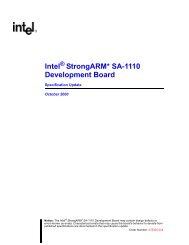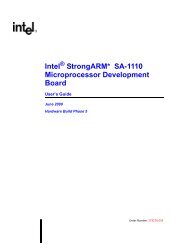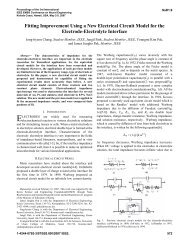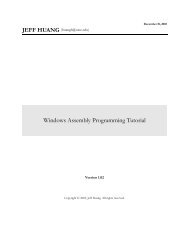Beej's Guide to Network Programming Using Internet Sockets
Beej's Guide to Network Programming Using Internet Sockets
Beej's Guide to Network Programming Using Internet Sockets
- No tags were found...
You also want an ePaper? Increase the reach of your titles
YUMPU automatically turns print PDFs into web optimized ePapers that Google loves.
Beej’s <strong>Guide</strong> <strong>to</strong> <strong>Network</strong> <strong>Programming</strong> <strong>Using</strong> <strong>Internet</strong> <strong>Sockets</strong> 408. Man PagesIn the Unix world, there are a lot of manuals. They have little sections that describe individualfunctions that you have at your disposal.Of course, manual would be <strong>to</strong>o much of a thing <strong>to</strong> type. I mean, no one in the Unix world,including myself, likes <strong>to</strong> type that much. Indeed I could go on and on at great length about howmuch I prefer <strong>to</strong> be terse but instead I shall be brief and not bore you with long-winded diatribesabout how utterly amazingly brief I prefer <strong>to</strong> be in virtually all circumstances in their entirety.[Applause]Thank you. What I am getting at is that these pages are called “man pages” in the Unix world,and I have included my own personal truncated variant here for your reading enjoyment. The thingis, many of these functions are way more general purpose than I’m letting on, but I’m only going<strong>to</strong> present the parts that are relevant for <strong>Internet</strong> <strong>Sockets</strong> <strong>Programming</strong>.But wait! That’s not all that’s wrong with my man pages:• They are incomplete and only show the basics from the guide.• There are many more man pages than this in the real world.• They are different than the ones on your system.• The header files might be different for certain functions on your system.• The function parameters might be different for certain functions on your system.If you want the real information, check your local Unix man pages by typing man whatever,where “whatever” is something that you’re incredibly interested in, such as “accept”. (I’m sureMicrosoft Visual Studio has something similar in their help section. But “man” is better because itis one byte more concise than “help”. Unix wins again!)So, if these are so flawed, why even include them at all in the <strong>Guide</strong>? Well, there are a fewreasons, but the best are that (a) these versions are geared specifically <strong>to</strong>ward network programmingand are easier <strong>to</strong> digest than the real ones, and (b) these versions contain examples!Oh! And speaking of the examples, I don’t tend <strong>to</strong> put in all the error checking because itreally increases the length of the code. But you should absolutely do error checking pretty muchany time you make any of the system calls unless you’re <strong>to</strong>tally 100% sure it’s not going <strong>to</strong> fail,and you should probably do it even then!












